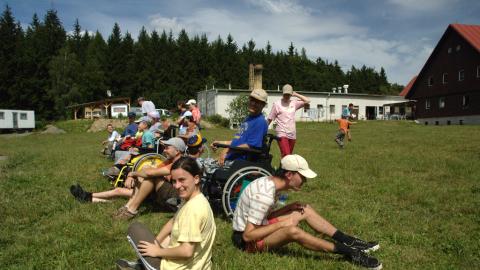Disability Concerns, Faith Nurture
Teaching Children About Inclusion
0 comments
288 views

Inclusion is the idea that all people of all abilities are to be active integrated members of their community. How do you teach your children to be inclusive? What are the intentional actions and discussions that you have to guide your children to embrace people of all abilities?
As one educator points out, “[Inclusion] challenges our sense of community, our assumptions about learning, our capacity for compassion, the limits of our generosity, and our definition of success.” Being inclusive benefits everyone in our society.
I Corinthians 12: 21-26 points out:
The eye cannot say to the hand, “I don’t need you!” And the head cannot say to the foot, “I don’t need you!” No, those parts of the body that seem to be weaker are actually very important. And the parts that we think are not worth very much are the parts we give the most care to. And we give special care to the parts of the body that we don’t want to show. The more beautiful parts don’t need this special care. But God put the body together and gave more honour to the parts that need it. God did this so that our body would not be divided. God wanted the different parts to care the same for each other. If one part of the body suffers, then all the other parts suffer with it. Or if one part is honored, then all the other parts share its honor.
This is more than just Biblical care and compassion, but recognition that each person is a contributor to the community, be it the school community, the church community or the neighbourhood in which one lives. Families can’t do it on their own; legal frameworks and policies and programs on their own don’t make it possible. It takes a village, a community where children are valued, where responsibility is shared, to enable families to raise their children, to enable children to flourish. As families that focus on tangible demonstrations of faith formation, we continue to strive to give opportunities to be community builders, God worshipers, justice seekers, servant workers, beauty creators, creation enjoyers, earth keepers, idol discerners, image reflectors and order discoverers. All of these concrete descriptions of Christian discipleship mentioned above could be demonstrated within inclusive practices, and specifically, community building which can be defined in terms of acceptance, belonging and community.
At its heart, inclusion is recognition that every child that you meet is celebrated and valued, because they are made in the image of God. When we meet another person, we are on holy ground, because that person is an image bearer. Seeing all people as image bearers gives value and equality to everyone.
This article (from 2014) was originally posted at www.kidscorner.net
Disability Concerns, Church Admin & Finance
Disability Concerns, Church Admin & Finance
Disability Concerns, Training and Education
Disability Concerns
Connect to The Network and add your own question, blog, resource, or job.
Add Your Post
Let's Discuss
We love your comments! Thank you for helping us uphold the Community Guidelines to make this an encouraging and respectful community for everyone.